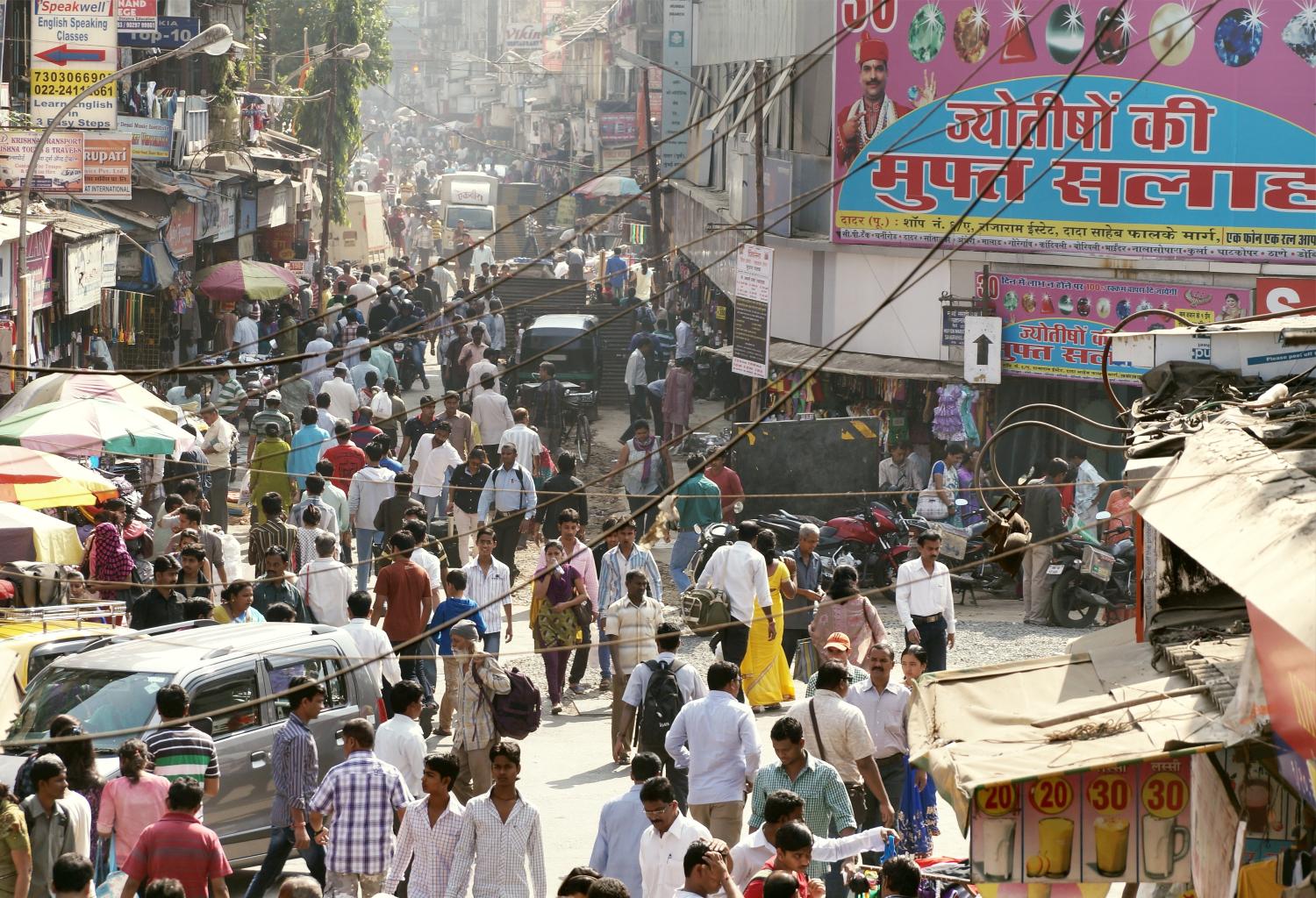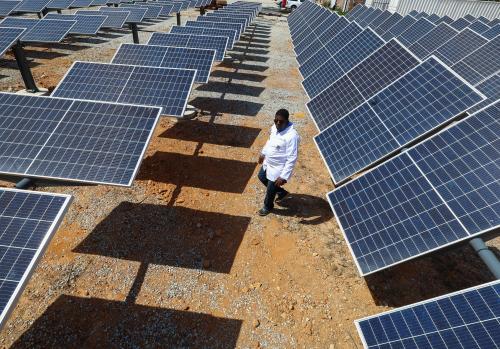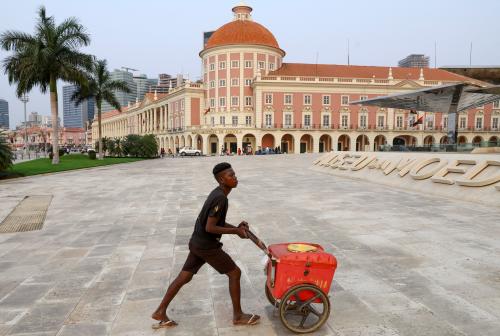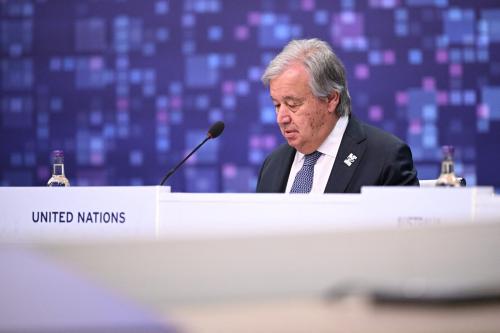The papers summarized here are part of the Spring 2023 edition of the Brookings Papers on Economic Activity (BPEA), the leading conference series and journal in economics for timely, cutting-edge research about real-world policy issues. The conference drafts of these papers were presented at the Spring 2023 BPEA Conference (recordings and slides are available via the link). The final versions were published in the Spring 2023 issue by Johns Hopkins University Press. Submit a proposal to present at a future BPEA conference here.
Download final papers, discussion comment, and general discussion summary
Download online appendices for Acharya paper and Carvalho & Nechio paper
Download data/programs for Carvalho & Nechio paper
Economists explored challenges and opportunities confronting three important emerging market economies—India, Brazil, and China—in papers prepared for a panel discussion at the Brookings Papers on Economic Activity (BPEA) conference on March 30.
India at 75: Replete with Contradictions, Brimming with Opportunities, Saddled with Challenges
Viral Acharya of New York University writes that India could potentially become “the next game in town” as international manufacturers adopt a “China Plus One” strategy of diversifying operations beyond China. But, to do so, it must focus on developing and maintaining sound policies, he writes.
India has experienced a K-shaped recovery since the start of the COVID-19 pandemic three years ago: Urban India has recovered but rural India lags behind, Acharya writes. He notes that, despite a booming stock market, India’s level of gross domestic product remains 6% lower than implied by its pre-pandemic trend.
“Much is at stake, for India and the world.”
However, India’s advantages include a strong interest in entrepreneurship among top university students, a healthy banking system, and what is considered the best “digital plumbing” in the world, he writes. To capitalize on its advantages, Acharya recommends that India focus on reforms in five areas:
- Increasing its share of global goods trade by reducing its “way too high and protectionist” tariffs, perhaps through a calibrated three-year plan.
- Dismantling its competition-stifling industrial conglomerates through trust busting or at least reducing their market power through legal and regulatory changes that make it economically unattractive for them to remain large.
- Ensuring India’s bankruptcy code can handle large conglomerate bankruptcies by requiring them to prepare “living wills” to help plan their resolution and, independently, speeding up the 18- to 24-month time it takes to resolve defaulted companies.
- Restoring macroeconomic balance by recommitting to reducing its budget deficits and by raising interest rates further to reduce inflation to the Central Bank of India’s 4% target.
- Addressing skills and education gaps by, for example, setting up public charter schools to provide high-quality STEM (science, technology, engineering, and mathematics) education and by giving corporations incentives to bring more women into the labor force.
“Much is at stake, for India and the world,” Acharya writes. “It would be nice if India can get it right in the coming decade.”
Challenges to Disinflation: The Brazilian Experience
Carlos Carvalho of Kapitalo Investimentos and PUC-Rio and Fernanda Nechio of the Federal Reserve Bank of San Francisco write that two previous bouts of above-target inflation in Brazil suggest it could be economically costly for the country to bring its post-COVID-19 inflation down to the central bank’s target.
Brazil’s central bank adopted an inflation target in 1999 and confronted significantly above-target inflation from 2002 until 2005 and again in 2015 and 2016. In both cases, fiscal policy concerns were high and expectations for future inflation became unanchored from the target, the authors write. The central bank had to raise interest rates significantly to bring inflation down and restore its credibility—but both times at the cost of a recession, they write.
In response to the shutdowns and economic hardship created by the pandemic, Brazil, like many other countries, cut interest rates and quickly ramped up government programs to support households and businesses, the authors note. But, as in many other countries, fiscal and monetary stimulus, among other factors, contributed to a sharp increase in Brazil’s inflation since 2021. Expectations for future inflation became unanchored around September 2021 and, according to the authors, have slipped further since the presidential election in October 2022 and promises of considerable fiscal expansion.
“The combination of fiscal concerns and unanchored expectations in a high-inflation environment are all too familiar for Brazil,” the authors write. “The similarities between the two previous episodes suggest the path ahead for disinflation will be extremely challenging, unless policies change direction.”
They note that Brazil’s experience could offer lessons for other countries, perhaps even advanced-economy countries such as the United States and the United Kingdom, which also are experiencing above-target inflation. They note that even for those economies, policy credibility may be challenged.
Has China’s Growth Gone from Miracle to Malady?
Eswar Prasad of Cornell University and The Brookings Institution writes that China could continue to defy long-standing predictions of economic collapse if its leaders succeed in reforming its institutional framework, improving productivity, and strengthening its financial system.
China’s growth over the past three decades has been remarkable, Prasad writes. Its gross domestic product in 2022 was 73% of the United States’s gross domestic product, more than 10 times the 7% ratio in 1990. He discusses the sources of China’s growth and its vulnerabilities. He then highlights areas where reforms are needed for China to continue growing, albeit more moderately than earlier in its long expansion.
“The underpinnings of China’s growth seem fragile.”
According to Prasad, China’s vulnerabilities include a weak financial and institutional framework, a bloated state sector, and an authoritarian government. Nevertheless, through the years the government has maneuvered the economy around various “plausible doomsday scenarios,” he writes.
To maintain economic progress, China should better allocate resources within its economy to its most dynamic parts (the services sector and small- and medium-sized enterprises), Prasad writes. That requires fixing China’s banking system and financial markets and tightening regulation. China’s banks must remove bad loans to state enterprises from their balance sheets. And better corporate governance and accounting standards are needed to provide stock and bond investors with information about Chinese companies.
“The underpinnings of China’s growth seem fragile,” Prasad writes. “…Things that must end do often end suddenly and in unpredictable ways. Yet, if the government plays its cards right, one could equally well envision a more benign future for the Chinese economy.”
CITATION
Acharya, Viral V. 2023. “India at 75: Replete with Contradictions, Brimming with Opportunities, Saddled with Challenges.” Brookings Papers on Economic Activity. Spring. 185-215.
Carvalho, Carlos and Fernanda Nechio. 2023. “Challenges to Disinflation: The Brazilian Experience.” Brookings Papers on Economic Activity. Spring. 217-241.
Prasad, Eswar. 2023. “Has China’s Growth Gone from Miracle to Malady?” Brookings Papers on Economic Activity. Spring. 243-270.
Rogoff, Kenneth. 2023. “Comment on ‘Panel on Emerging Market Challenges.’” Brookings Papers on Economic Activity. Spring. 271-282.
Discussant

-
Acknowledgements and disclosures
Viral V. Acharya was deputy governor of the Reserve Bank of India from January 2017 to July 2019. The author did not receive financial support from any firm or person for this paper or from any firm or person with a financial or political interest in this paper. The author is not currently an officer, director, or board member of any organization with a financial or political interest in this paper.
Fernanda Nechio was deputy governor at the Central Bank of Brazil between July 2019 and May 2021. Carlos Carvalho was deputy governor of the Central Bank of Brazil between July 2016 and September 2019. The authors did not receive financial support from any firm or person for this paper or from any firm or person with a financial or political interest in this paper. The authors are not currently an officer, director, or board member of any organization with a financial or political interest in this paper.
Eswar Prasad is the Tolani Senior Professor of Trade Policy and professor of economics at Cornell University, and a senior fellow at the Brookings Institution. Brookings is financed through the support of a diverse array of foundations, corporations, governments, and individuals, as well as an endowment. A list of donors can be found in our annual reports published online here. The findings, interpretations, and conclusions in this paper are solely those of its author and are not influenced by any donation.
Papers prepared for this panel were guest-edited by Maurice Obstfeld.
David Skidmore authored the summary language for this paper. Chris Miller assisted with data visualization.







